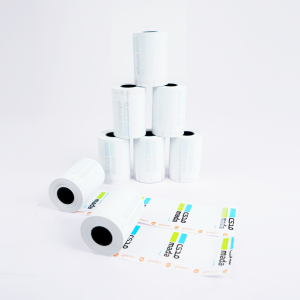Thermal paper is a unique paper that reacts chemically to form an image when heated. It is widely used in various industries, including retail, banking, transportation and healthcare.
Thermal paper consists of two main parts: paper substrate and special coating. The paper substrate provides the base, while the coating contains a combination of leuco dyes, developers, and other chemicals that react with heat. When the thermal paper passes through the thermal printer, the heating process begins. The printer applies heat to specific areas of the thermal paper, causing the chemical coating to react in a localized manner. It is this reaction that creates visible images and texts. The secret lies in the dyes and developers in the coating of thermal paper. When heated, the developer reacts to form a color image. These dyes are usually colorless at room temperature but change color when heated, forming visible images or text on the paper.
There are two main types of thermal paper: direct thermal and thermal transfer. Direct Thermal: In direct thermal printing, the heating element of the thermal printer is in direct contact with the thermal paper. These heating elements selectively heat specific areas on the paper, activating the chemicals in the coating and producing the desired image. Direct thermal printing is typically used for short-term applications such as receipts, tickets and labels. Thermal transfer printing: Thermal transfer printing works slightly differently. Use ribbon coated with wax or resin instead of thermal paper that reacts directly with heat. Thermal printers apply heat to the ribbon, causing the wax or resin to melt and transfer to the thermal paper. This method allows for more durable prints and is often used in applications that require long-term availability, such as barcode labels, shipping labels, and product stickers.
Thermal paper has many advantages. It provides fast, high-quality printing without the need for ink or toner cartridges. This eliminates the need for frequent replacements and reduces operating costs. In addition, thermal paper printing is not easy to fade and stain, ensuring the long-term readability of printed information. However, it’s worth noting that thermal printing can be affected by external factors. Excessive exposure to heat, light, and humidity may cause printed images to fade or degrade over time. Therefore, it is crucial to store thermal paper in a cool, dry environment to maintain its quality.
In summary, thermal paper is a remarkable innovation that relies on a chemical reaction between a dye and developer to produce images and text when exposed to heat. Its ease of use, cost-effectiveness and durability make it the first choice in various industries. Whether printing receipts, tickets, labels or medical reports, thermal paper remains an essential part of modern printing technology.
Post time: Nov-11-2023



